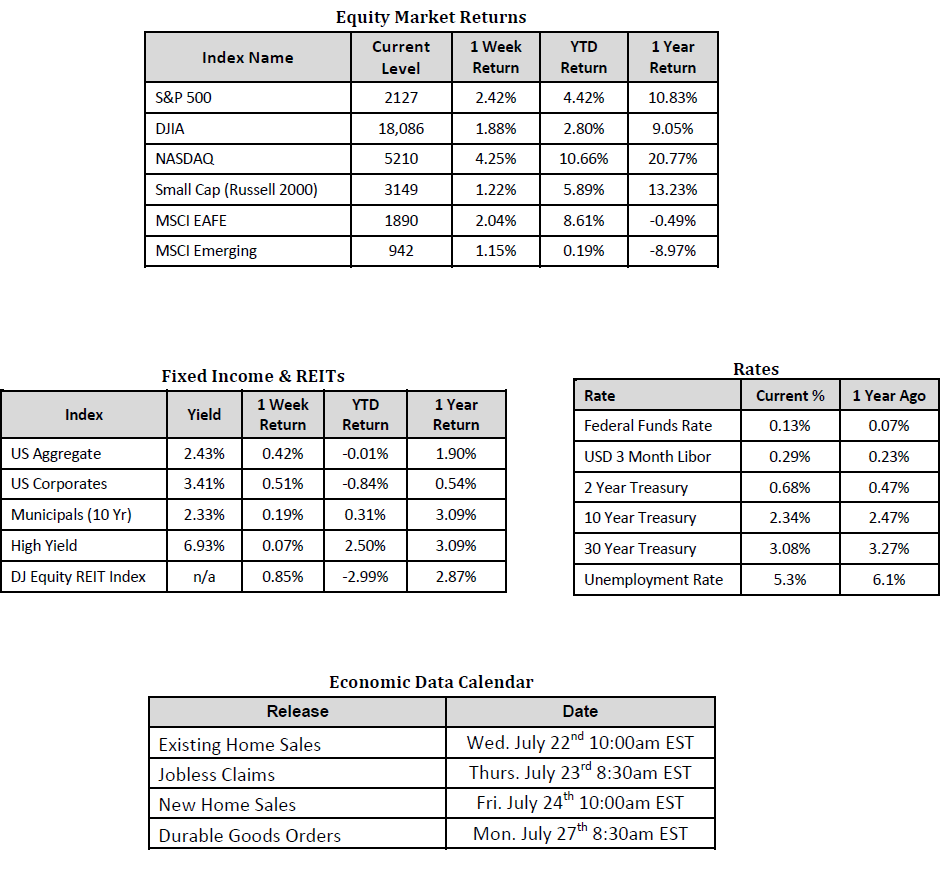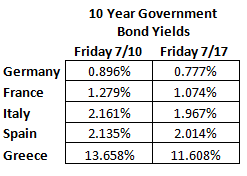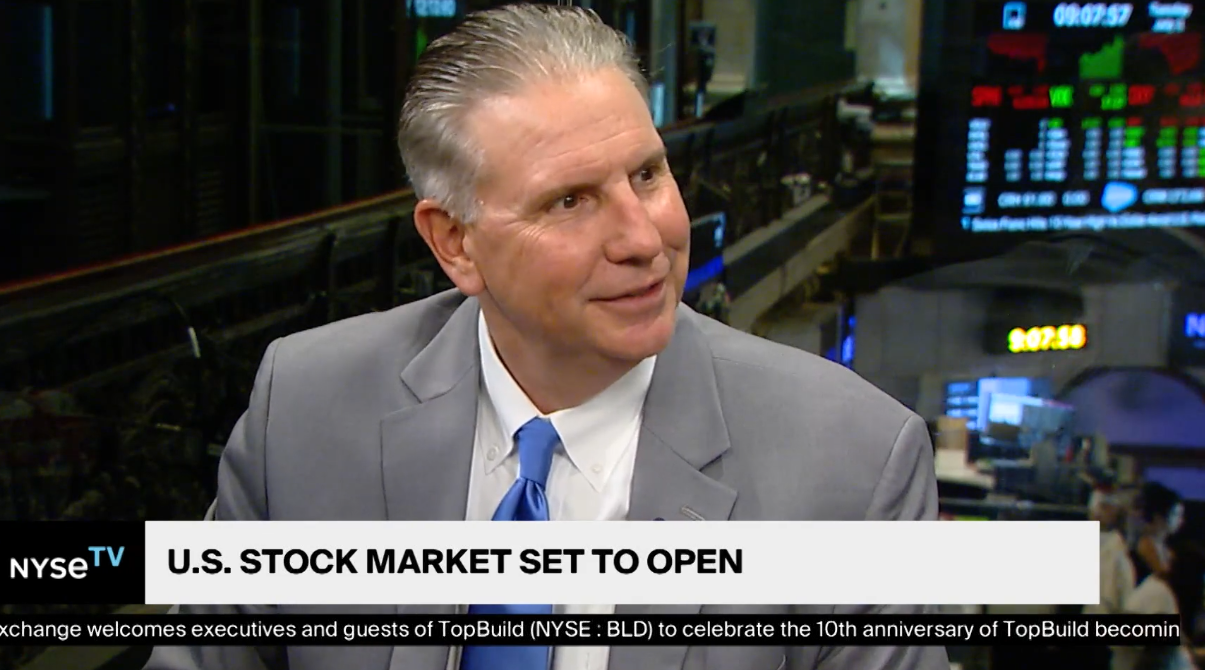
A Mixed Cocktail of Certainty, Earnings and Fed Talk Fuels Global Capital Markets
Market Overview
Happening Now
U.S. markets, as measured by the S&P 500 Index, posted a 2.4% gain last week on the back of a Greek debt deal, a solid start to quarterly earnings reports and an optimistic economic outlook from Janet Yellen of the Federal Reserve. As we discussed last week, the Greek government and their creditors agreed to a deal that should, for now at least, allow normalcy to return to the region in the form of reduced volatility in capital markets. International developed markets, as measured by the MSCI EAFE Index, reacted positively to this deal and posted a weekly return of 1.2% while bond yields across the Eurozone declined in light of less perceived sovereign credit risk. Below is table showing the yields on 10 year government bonds from this past Friday, July 17 vs. the prior Friday, July 10:
As of Friday 7/17, 61 companies in the S&P500 Index had reported Q2 earnings and 72% of them had beaten bottom line expectations. Data provider Factset provides a “blended earnings” report that incorporates companies that have reported as well as the earnings estimates of companies yet to report. The latest report showed that the decline in year-over-year earnings had improved from an estimated -4.5% as of the end of Q2 to a current estimated decline of -3.7%. 131 companies are set to report earnings this week, including the world’s largest company; Apple, which is expected to post earnings per share of $1.80 – a 41% increase from last year.
Lastly, Fed Chair Janet Yellen delivered her Semiannual Monetary Policy Report to Congress Wednesday and expressed an optimistic outlook for the U.S. economy:
“Looking forward, prospects are favorable for further improvement in the U.S. labor market and the economy more broadly. Low oil prices and ongoing employment gains should continue to bolster consumer spending, financial conditions generally remain supportive of growth, and the highly accommodative monetary policies abroad should work to strengthen global growth. In addition, some of the headwinds restraining economic growth, including the effects of dollar appreciation on net exports and the effect of lower oil prices on capital spending, should diminish over time. As a result, the FOMC expects U.S. GDP growth to strengthen over the remainder of this year and the unemployment rate to decline gradually.”
Consistent with this view, she went on to suggest that it is likely the first Fed Funds rate hike will come this year. Echoing this sentiment, St. Louis Fed President James Bullard in an interview with Fox Business Monday morning, said he believes there is a greater than 50% probability the rate hike will occur at the September meeting. We are currently in the same camp regarding the September timeframe for the first potential 0.25% rate hike.
Sources: Equity Market, Fixed Income and REIT returns from JP Morgan as of 7/17/15. Rates and Economic Calendar Data from Bloomberg as of 7/20/15.
Factset: http://www.factset.com/websitefiles/PDFs/earningsinsight/earningsinsight_7.17.15
Important Information and Disclaimers
Disclosures: Past performance does not guarantee future results. We have taken this information from sources that we believe to be reliable and accurate. Hennion and Walsh cannot guarantee the accuracy of said information and cannot be held liable.
Investing in foreign securities presents certain risks not associated with domestic investments, such as currency fluctuation, political and economic instability, and different accounting standards. This may result in greater share price volatility. These risks are heightened in emerging markets.
There are special risks associated with an investment in real estate, including credit risk, interest rate fluctuations and the impact of varied economic conditions. Distributions from REIT investments are taxed at the owner’s tax bracket.
The prices of small company and mid cap stocks are generally more volatile than large company stocks. They often involve higher risks because smaller companies may lack the management expertise, financial resources, product diversification and competitive strengths to endure adverse economic conditions.
Investing in commodities is not suitable for all investors. Exposure to the commodities markets may subject an investment to greater share price volatility than an investment in traditional equity or debt securities. Investments in commodities may be affected by changes in overall market movements, commodity index volatility, changes in interest rates or factors affecting a particular industry or commodity.
Products that invest in commodities may employ more complex strategies which may expose investors to additional risks.
Investing in fixed income securities involves certain risks such as market risk if sold prior to maturity and credit risk especially if investing in high yield bonds, which have lower ratings and are subject to greater volatility. All fixed income investments may be worth less than original cost upon redemption or maturity. Bond Prices fluctuate inversely to changes in interest rates. Therefore, a general rise in interest rates can result in the decline of the value of your investment.
Definitions
MSCI- EAFE: The Morgan Stanley Capital International Europe, Australasia and Far East Index, a free float-adjusted market capitalization index that is designed to measure developed-market equity performance, excluding the United States and Canada.
MSCI-Emerging Markets: The Morgan Stanley Capital International Emerging Market Index, is a free float-adjusted market capitalization index that is designed to measure the performance of global emerging markets of about 25 emerging economies.
Russell 3000: The Russell 3000 measures the performance of the 3000 largest US companies based on total market capitalization and represents about 98% of the investible US Equity market.
ML BOFA US Corp Mstr [Merill Lynch US Corporate Master]: The Merrill Lynch Corporate Master Market Index is a statistical composite tracking the performance of the entire US corporate bond market over time.
ML Muni Master [Merill Lynch US Corporate Master]: The Merrill Lynch Municipal Bond Master Index is a broad measure of the municipal fixed income market.
Investors cannot directly purchase any index.
LIBOR, London Interbank Offered Rate, is the rate of interest at which banks offer to lend money to one another in the wholesale money markets in London.
The Dow Jones Industrial Average is an unweighted index of 30 “blue-chip” industrial U.S. stocks.
The S&P Midcap 400 Index is a capitalization-weighted index measuring the performance of the mid-range sector of the U.S. stock market, and represents approximately 7% of the total market value of U.S. equities. Companies in the Index fall between S&P 500 Index and the S&P SmallCap 600 Index in size: between $1-4 billion.
DJ Equity REIT Index represents all publicly traded real estate investment trusts in the Dow Jones U.S. stock universe classified as Equity REITs according to the S&P Dow Jones Indices REIT Industry Classification Hierarchy. These companies are REITSs that primarily own and operate income-producing real estate





